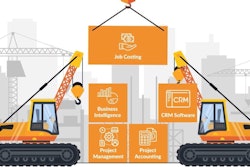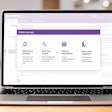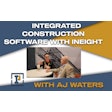
PART I 2024 Construction ERP Snapshot: Executive Insights
PART II INFOGRAPHIC: IRONPROS Construction ERP Landscape
PART III Editorial Board Comments on the State of Construction ERP
Contractors looking for a system of record in 2024 have a growing number of choices representing a broad spectrum of functional footprints from the general ledger and accounting through to various operational disciplines.
Construction-related enterprise resource planning (ERP) software may consist of a broad ERP solution for multiple industries, perhaps extended by an independent software vendor (ISV) product that contributes industry-specific functionality. That is why we see vendors like Oracle, NetSuite, IFS and Acumatica on the list. We include Procore on our list of construction ERP products because it addresses the entire quote-to-cash project lifecycle, and a contractor would really only need to add general ledger functionality from an accounting program.
Other products on the list that are not traditional ERP applications are those aimed at small contractors, down to the one-person operation. Applications like Jobber, ServiceTitan and those from WorkWave may encompass the entire revenue cycle, with tools for marketing and customer acquisition, service provision, billing and other core functions. Some of these products, which admittedly aim more at installation, repair and technicians visiting multiple sites per day, are adding nested task capabilities that facilitate management of a small construction project.
Construction ERP for Different Size Contractors
In our IRONPROS 2024 Construction ERP Snapshot, applications are classified as being appropriate for small-to-medium business (SMB), middle market or enterprise-size construction entities. What makes a construction business software product like ERP a better fit for a contractor based on size? A few things:
Complexity: Larger contracting environments also tend to be more complex, which can require a more robust chart of accounts, configurable revenue recognition and billing options to meet owner demands, the ability to handle multiple legal entities, sophisticated risk management and more. ERP for larger construction environments or larger projects will require more introspection during implementation to ensure the different requirements a contractor faces now and those they will face in the future are addressed. Success hinges on meeting the needs of and training users and stakeholders in multiple departments and jobs also adds to the up-front cost.
Partnerships: Apart from looking at customer case studies on a vendor web site, a contractor can get a sense of whether they are a fit for a construction ERP product by looking at what standard integrations they offer. Acumatica for instance has standard integrations with the Assignar Self Perform Sub Contractor Field Ops Solution, Arcoro’s ExakTime Time and Attendance and Arcoro’s HR and Workforce Management Solution, RedTeam Commercial Construction Management Software and WorkMax TIME. This alone would suggest this is a solution for middle-market contractors, and can extend into some smaller ones as well.
Broader ERP solutions may partner in this fashion with packaged construction software but may also have a platform where independent software vendors (ISVs) can build dedicated solutions and extensions. This tight pairing of core ERP form a major technology vendor like Microsoft, Oracle or even SAP with a dedicated construction solution may be attractive to larger or more diversified organizations.
Cloud Construction ERP
ERP products dedicated to construction will offer not just core accounting but extensive project cost management, contract management and other project-based functionality in a package that may extend well into operations. There are some venerable and proven solutions in this space, including Sage 100 Contractor and Sage 300 Construction and Real Estate. Also among these functionally mature solutions are Viewpoint Vista and Viewpoint Spectrum, now part of Trimble Construction One.
These familiar applications can handle diverse construction requirements for contractors of various sizes. These applications may often be run on-premise, or in an environment managed by the software vendor or a third party. These applications will have deeper functionality in some areas at this point than, for instance, Intacct, which Sage acquired in 2017.
“As customer demand moves to the cloud and away from traditional monolithic ERP suites, the acquisition strengthens Sage’s position as providing the first and last cloud Financial Management Solution a customer will ever need from start-up to global enterprise, whilst integrating seamlessly with their other enterprise applications,” Sage said in a release at the time.
The move to a cloud environment has influenced not just where the software resides, but how it is paid for. While some construction software vendors will still sell a perpetual license, newer and cloud-first products will be sold on a subscription only basis.
When evaluating solutions that are available on-premise, contractors will want to come to an understanding of the vendor’s strategy to expose product functionality for integration, which is more easily supported in a modern, multi-tenant software-as-a-service (SaaS) environment. Multi-tenant SaaS is also the most profitable model for the software vendor, followed by single-tenant SaaS. While contractors should not fear that on-premise solutions will be out-of-support in the intermediate future, cloud-first products will be easier to extend, easier for the vendor to evolve and will likely get most of the research and development dollars.















